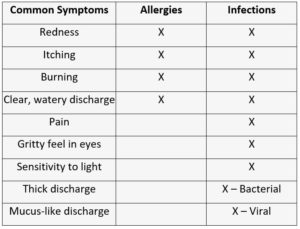March 13, 2019 | Black & Kletz Allergy

It is very important for a board certified allergist to distinguish the difference between these two conditions as the treatment options are determined by the causative factors and differ greatly.
Though it is not always possible to differentiate the conditions by symptoms alone, the following information can be a helpful beginning.
If the discharge from the eye(s) is anything more than normal tears, it is more likely to be something more than allergies. Though allergies also can cause much discomfort, pain in the eye(s) is more indicative of an infectious process.
A definitive diagnosis can only be made by examination and testing by trained and experienced professionals.
Allergies are not contagious to others but infections can easily spread from person to person or from one eye to the other eye. The signs and symptoms of eye allergies (i.e., allergic conjunctivitis) are more likely to occur in both eyes, whereas infections are more likely to develop in one eye initially, although both eyes may be affected.
Prevention and Treatment:
Allergic Conjunctivitis:
Prevention should include reducing one’s exposure to known allergens by restricting outdoor activities on high pollen days, keeping windows closed, keeping pets out of the bedrooms, and using air purifiers and dehumidifiers to minimize dust mite and mold growth.
Treatment involves using over-the-counter eye drops containing antihistamines and mast cell stabilizers. These are often helpful in relieving the itching and redness that are characteristic of allergic conjunctivitis. They can be supplemented with oral medications (e.g., antihistamines) especially if nasal and sinus symptoms are also present. Over-the-counter artificial tears also can help keep eyes moistened and flush out allergens. In case of persistent symptoms, certain nasal corticosteroids, but not all, have the indication to help alleviate the allergic eye symptoms that may be extremely bothersome to the allergic individual. Though they are more efficacious, the risks of adverse effects are also higher.
Allergy shots (i.e., allergy injections, allergy immunotherapy, allergy desensitization, allergy hyposensitization) is very effective in treating individuals with allergic conjunctivitis whether they have associated hay fever (i.e., allergic rhinitis) or not.
Infectious Conjunctivitis:
Prevention should entail avoiding exposure to people battling viral and bacterial infections to the best of their ability. In addition, frequent hand washing can reduce the risks of contracting and spreading infectious eye conditions.
The treatment of infectious conjunctivitis varies depending on the microorganism.
Most viral infections resolve after a few days without any specific antiviral medications. Lubricating eye drops and cold compresses can help relieve the discomfort and facilitate recovery.
Bacterial infections need antibiotic eye drops, instilled several times a day for about a week in order to treat the infections. Rarely infections can also be caused by fungi and/or parasites. In these rare cases, anti-fungal and anti-parasitic medications can be administered.
If eye infections are mistakenly self-treated with over-the-counter allergy medications, one can run the risk of damaging the eyes.
Other Ocular Allergies:
Of note, there are 3 other forms of ocular allergies that are more severe than allergic conjunctivitis which include the following:
Vernal keratoconjunctivitis (VKC): A chronic inflammatory swelling of the outer lining of the eyes due to an allergic reaction. It typically affects boys and young males who live in hot dry climates in a seasonal manner, most often occurring in the Spring and/or Summer. It usually occurs in patients with a family history of allergies. The classic symptoms may include watery eyes, itching, redness, and/or increased sensitivity to light (i.e., photophobia) of both eyes. The treatment is similar to that of allergic rhinitis (see below), but in addition, individuals with severe cases may need topical corticosteroids, cyclosporine, or tacrolimus. Rarely, oral corticosteroids may be necessary in recalcitrant cases. It should be noted that rarely, VKC can lead to corneal scarring and vision loss if not properly treated.
Atopic keratoconjunctivitis (AKC): A genetic disorder that is more common in adults (men more than women) where the immune system produces higher amounts of antibodies in response to a given allergen. Although AKC is perennial in nature, the symptoms may worsen in the Winter. Individuals usually have a history of eczema (i.e., atopic dermatitis). The typical symptoms may include red eyelids, burning, itching, watery eyes, and/or increased sensitivity to light (i.e., photophobia) of both eyes. The treatment is similar to that of VKC. It should be noted that rarely, AKC can lead to corneal scarring and vision loss as mentioned above with VKC. This complication however occurs more often in individuals with AKC than with VKC.
Giant papillary conjunctivitis (GPC): A disorder that causes inflammation in the inside part of the eyelid. It is most often caused by a reaction to eyelid movement over a foreign substance such as contact lenses. It can develop at any time after wearing contact lenses. An allergic reaction is thought to be one of the causes of GPC. Some individuals are allergic to either their contact lenses or the chemicals used to clean them. An allergic reaction between the skin of the eyelid and the contact lenses or chemicals may be a cause. Other causes of GPC may include repetitive rubbing of the eyes, eye implants, and/or sutures in the eyes from a previous eye surgery. The symptoms may include watery eyes, redness, burning, itching, and/or pain. Treatment includes changing one’s contact lens regularly and limiting the time of wearing them to a few hours per day. Disposable contact lenses may be of some benefit as well. In more severe cases, the individual should stop using contact lenses altogether.
The board certified allergy specialist physicians at Black and Kletz Allergy have over 50 years of experience in diagnosing and treating all types of eye conditions whether allergic or infectious. We treat both pediatric and adult patients. Black & Kletz Allergy has 3 convenient locations with on-site parking located in Washington, DC, McLean, VA (Tysons Corner, VA), and Manassas, VA. The Washington, DC and McLean, VA offices are Metro accessible and we offer a free shuttle that runs between the McLean, VA office and the Spring Hill metro station on the silver line. To schedule an appointment, please call any of our offices or you may click Request an Appointment and we will respond within 24 hours by the next business day. We have been servicing the greater Washington, DC metropolitan area for many decades and we look forward to providing you with the utmost state-of-the-art allergy care in a welcoming and pleasant environment.













